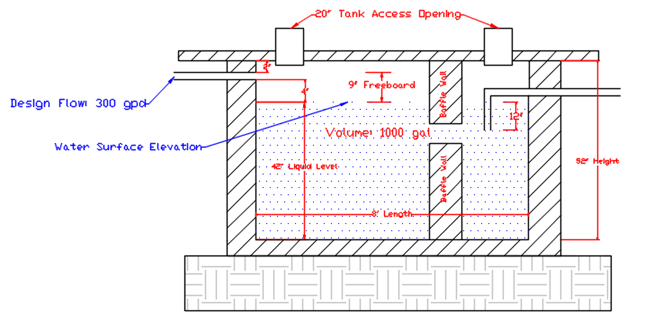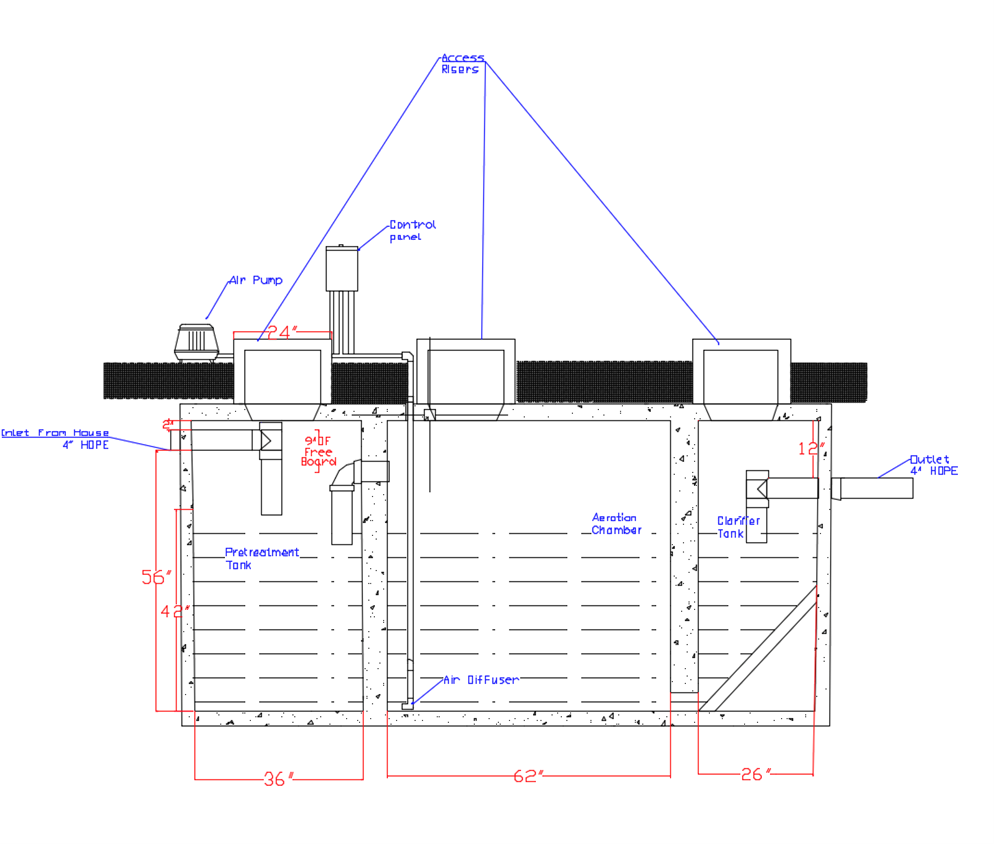
The standard Septic System was not designed to be a lone system, as it would not produce water of irrigation quality. However, it is necassary to be designed as it is the basis for two other design alternatives.
The Septic System includes a single tank where raw wastewater is put in. This water settles out heavier particles, stops light fats, oils, and greases on the surface, and allows for some biological activity in an anaerobic environment to begin to treat the water. When more water flows in, the discharge flows out on the other side of a baffle that divides the tank. This discharge is then, in a normal system, discharged directly to the leach field.


The Gray-Black Water system removes the main issue of fecal-contaminated water by separating it. Gray water, which is any water that doesn't have an abundant biological load (laundry, shower, bathroom sink, etc) in it. This water is separated from black water (water from the kitchen sink, dishwasher, toilets) and sends it to a small sand filter to treat the water for contaminants. This sand filter can be smaller since the contamination is much more minor in gray water. This filter will then collect the gray water for use in irrigation or overflow to the leach field.
The Black water is sent to the Septic Tank as designed above, which must be able to handle the entire household wastewater load should something happen to the Gray water filter, as per Arizona Administrative Code. An overflow exists in the sand filter to send water to the septic tank should something go wrong.


The third system is a Sand Filter. It runs directly after the Septic Tank to treat the water that discharges from it. This larger system is capable of treating the higher biological load within the septic water and thus does not require separation of the water streams like the gray water system. This water is then sent to a surge tank where it is kept for irrigation use or eventually discharged to the leach field.


The last systm, and most complicated of the alternatives, is the Mini Wastewater Treatment Plant (Mini WWTP). This system, also known as an Aerbobic Treatment System, has many of the same compoents found within a municiple water treatment plant, and is designed to create an effluent of the highest quality. This effluent would be exceptional for irrigation use after is is collected in a surge tank, with the remaining being discharged into the leach field. However, this is most complicated system, and may not be suitable for the client.


These alternatives were then analysed for a few major traits: installation cost, maintenance cost, maintenance required, treated water quality, and ease of use. These traits were weighted, and then turned into numerical values in the Design Decision Matrix. This matrix helped decide upon which alternative to use.

Through the analysis of a design decision matrix, it was decided that the sand filter was the best possible alternative for the client, and thus more effort was put into its design following this alternatives stage. The following is a graphic of water flow through the final system.

The final system includes an 1000 gallon septic tank, followed by a 15ft x 15ft sand filter directly after it. There is a 500 gallon tank setup to hold water for dosing into the sand filter between these two. Following the sand filter is a 350 gallon tank that will hold the treated effluent. This water can either be pumped out for irrigation use of will automatically empty to the leach field to prevent the water from becoming more septic at this stage. This discharge is then sent to two 40ft 4" HDPE perforated pipes which make up the leach field.
Last Updated 12/5/2022